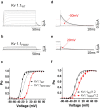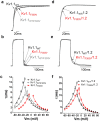A channelopathy mutation in the voltage-sensor discloses contributions of a conserved phenylalanine to gating properties of Kv1.1 channels and ataxia
- PMID: 28676720
- PMCID: PMC5496848
- DOI: 10.1038/s41598-017-03041-z
A channelopathy mutation in the voltage-sensor discloses contributions of a conserved phenylalanine to gating properties of Kv1.1 channels and ataxia
Abstract
Channelopathy mutations prove informative on disease causing mechanisms and channel gating dynamics. We have identified a novel heterozygous mutation in the KCNA1 gene of a young proband displaying typical signs and symptoms of Episodic Ataxia type 1 (EA1). This mutation is in the S4 helix of the voltage-sensing domain and results in the substitution of the highly conserved phenylalanine 303 by valine (p.F303V). The contributions of F303 towards K+ channel voltage gating are unclear and here have been assessed biophysically and by performing structural analysis using rat Kv1.2 coordinates. We observed significant positive shifts of voltage-dependence, changes in the activation, deactivation and slow inactivation kinetics, reduced window currents, and decreased current amplitudes of both Kv1.1 and Kv1.1/1.2 channels. Structural analysis revealed altered interactions between F303V and L339 and I335 of the S5 helix of a neighboring subunit. The substitution of an aromatic phenylalanine with an aliphatic valine within the voltage-sensor destabilizes the open state of the channel. Thus, F303 fine-tunes the Kv1.1 gating properties and contributes to the interactions between the S4 segment and neighboring alpha helices. The resulting channel's loss of function validates the clinical relevance of the mutation for EA1 pathogenesis.
Conflict of interest statement
The authors declare that they have no competing interests.
Figures








Comment in
-
Commentary: A channelopathy mutation in the voltage-sensor discloses contributions of a conserved phenylalanine to gating properties of Kv1.1 channels and ataxia.Front Cell Neurosci. 2018 Jun 20;12:174. doi: 10.3389/fncel.2018.00174. eCollection 2018. Front Cell Neurosci. 2018. PMID: 29973872 Free PMC article. No abstract available.
Similar articles
-
Clinical Spectrum of KCNA1 Mutations: New Insights into Episodic Ataxia and Epilepsy Comorbidity.Int J Mol Sci. 2020 Apr 17;21(8):2802. doi: 10.3390/ijms21082802. Int J Mol Sci. 2020. PMID: 32316562 Free PMC article. Review.
-
A novel KCNA1 mutation in a patient with paroxysmal ataxia, myokymia, painful contractures and metabolic dysfunctions.Mol Cell Neurosci. 2017 Sep;83:6-12. doi: 10.1016/j.mcn.2017.06.006. Epub 2017 Jun 28. Mol Cell Neurosci. 2017. PMID: 28666963
-
The episodic ataxia type 1 mutation I262T alters voltage-dependent gating and disrupts protein biosynthesis of human Kv1.1 potassium channels.Sci Rep. 2016 Jan 18;6:19378. doi: 10.1038/srep19378. Sci Rep. 2016. PMID: 26778656 Free PMC article.
-
Episodic ataxia type 1 mutations affect fast inactivation of K+ channels by a reduction in either subunit surface expression or affinity for inactivation domain.Am J Physiol Cell Physiol. 2011 Jun;300(6):C1314-22. doi: 10.1152/ajpcell.00456.2010. Epub 2011 Feb 9. Am J Physiol Cell Physiol. 2011. PMID: 21307345
-
Kv1.1 Channelopathies: Pathophysiological Mechanisms and Therapeutic Approaches.Int J Mol Sci. 2020 Apr 22;21(8):2935. doi: 10.3390/ijms21082935. Int J Mol Sci. 2020. PMID: 32331416 Free PMC article. Review.
Cited by
-
Clostridioides difficile toxin B alone and with pro-inflammatory cytokines induces apoptosis in enteric glial cells by activating three different signalling pathways mediated by caspases, calpains and cathepsin B.Cell Mol Life Sci. 2022 Jul 22;79(8):442. doi: 10.1007/s00018-022-04459-z. Cell Mol Life Sci. 2022. PMID: 35864342 Free PMC article.
-
Novel Genetic Variants Expand the Functional, Molecular, and Pathological Diversity of KCNA1 Channelopathy.Int J Mol Sci. 2023 May 16;24(10):8826. doi: 10.3390/ijms24108826. Int J Mol Sci. 2023. PMID: 37240170 Free PMC article. Review.
-
Mathematical models of C-type and N-type inactivating heteromeric voltage gated potassium channels.Front Cell Neurosci. 2024 Oct 8;18:1418125. doi: 10.3389/fncel.2024.1418125. eCollection 2024. Front Cell Neurosci. 2024. PMID: 39440001 Free PMC article.
-
Modeling the kinetics of heteromeric potassium channels.Front Cell Neurosci. 2022 Nov 10;16:1036813. doi: 10.3389/fncel.2022.1036813. eCollection 2022. Front Cell Neurosci. 2022. PMID: 36439203 Free PMC article.
-
Clinical Spectrum of KCNA1 Mutations: New Insights into Episodic Ataxia and Epilepsy Comorbidity.Int J Mol Sci. 2020 Apr 17;21(8):2802. doi: 10.3390/ijms21082802. Int J Mol Sci. 2020. PMID: 32316562 Free PMC article. Review.
References
Publication types
MeSH terms
Substances
LinkOut - more resources
Full Text Sources
Other Literature Sources

